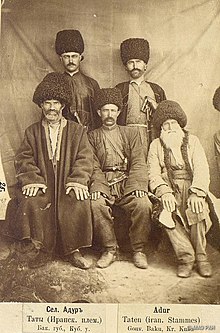 1880 photograph depicting a group of Tat men from the village of Adur in the Kuba Uyezd of the Baku Governorate of the Russian Empire | |
| Total population | |
|---|---|
| tens of thousands (various estimates)[citation needed] | |
| Regions with significant populations | |
| 25,218 (2009)[1] | |
| 1,585 (2010)[citation needed] | |
| Languages | |
| Tat, Azerbaijani, and Russian | |
| Religion | |
| Shia Islam (majority) | |
| Related ethnic groups | |
| Other Iranian peoples, Armeno-Tats | |
The Tat people or Transcaucasian Persians (also: Tat, Parsi, Daghli, Lohijon) are an Iranian people presently living within Azerbaijan and Russia (mainly Southern Dagestan). The Tats are part of the indigenous peoples of Iranian origin in the Caucasus.[2][3][4]
Tats use the Tat language, a southwestern Iranian language somewhat different from Standard Persian,[5][6] as well as Azerbaijani and Russian. Tats are mainly Shia Muslims with a significant Sunni Muslim minority.
- ^ "Demography of Azerbaijan".
- ^ H. Pilkington,"Islam in Post-Soviet Russia", Psychology Press, Nov 27, 2002 . pg 27: "Among other indigenous peoples of Iranian origin were the Tats, the Talishes and the Kurds"[1]
- ^ R. Khanam,"Encyclopaedic Ethnography of Middle-East and Central Asia:P-Z, Volume 1", Global Vision Publishing Ho, 2005. pg 746:"The contemporary Tats are the descendants of an Iranian-speaking population sent out of Persia by the dynasty of the Sasanids in the fifth to sixth centuries."
- ^ T. M. Masti︠u︡gina, Lev Perepelkin, Vitaliĭ Vi͡a︡cheslavovich Naumkin, "An Ethnic History of Russia: Pre-Revolutionary Times to the Present", Greenwood Publishing Group, 1996. pg 80:"The Iranian Peoples (Ossetians, Tajiks, Tats, Mountain Judaists)" [2]
- ^ Gruenberg, Alexander. (1966). "Tatskij jazyk". In: Vinogradov, V. V. (ed.), Jazyki narodov SSSR. Volume 1: Indoevropejskie jazyki, 281-301. Excerpt: "The Tat language belongs to the Southwest group of Iranian languages and is close in its grammatical structure and lexical content to the Persian and Tajik languages."
- ^ Authier, Gilles (2012). Grammaire juhuri, ou judéo-tat, langue iranienne des Juifs du Caucase de l'est. Wiesbaden: Reichert. Excerpt: "Judaeo-Tat has no particular affinity with the Persian varieties, spoken until recently by Jews of Bukhara, Yazd, Isfahan, Kerman, Hamadan, Kashan, and Nahavand. Contrary to these, Judaeo-Tat is a different language that is not intelligible with Standard Persian;",